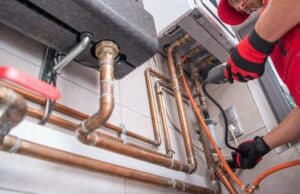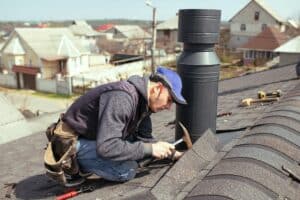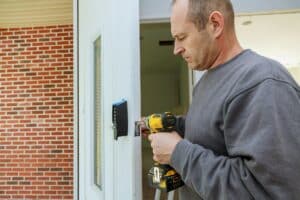What is property completion?
Property delivery is a crucial process that takes place upon the completion of a construction or renovation project of a building with apartments. It refers to the official moment when the contractor or developer formally transfers the building to the owner or manager. This step includes not only the completion of all physical work, but also a thorough inspection to ensure that the property meets all contractual and legal requirements. Accurately executing property delivery can help to prevent potential problems in the future and provides a solid basis for tenant occupancy of the building.
The property handover starts with a thorough inspection of the building. This involves experts examining every part of the structure, from the foundation to the roof, to ensure that everything meets the specifications and standards set out in the construction contract. If defects or imperfections are discovered, they are documented in a delivery report. The contractor must resolve these issues before the final handover takes place.
Another important aspect of property delivery is the legal and administrative formality. This includes handing over all relevant documentation such as warranties, installation manuals, and certificates of approval. These documents are essential for the future operation and maintenance of the building.
The importance of property delivery should not be underestimated. Correct delivery ensures that the owner receives the property in the agreed condition, free of structural and functional defects. In addition, it offers an organized transition to the rental phase, where tenants can move into a property that meets all legal standards and safety requirements.
In summary, property delivery is an essential process that requires diligence and attention to detail. It is a security measure, a legal requirement, and a quality control that is crucial for the successful management and occupancy of apartment complexes.
The importance of a caretaker in the delivery
When delivering a new building with apartments, the presence of a caretaker is essential. A caretaker plays a crucial role in facilitating the relocation process for the new tenants. Thanks to their knowledge and experience, caretakers can ensure a smooth transition to the new living environment. They offer support when moving in, so that the residents can move into their new home without unnecessary stress.
In addition to helping them move in, a caretaker is also tasked with informing tenants about the various amenities and facilities within the building. This includes explanations of common areas, waste disposal, parking facilities, and safety procedures. By conveying this information in a clear and structured manner, the caretaker fosters a sense of ease and trust among the new tenants.
Another important aspect of the caretaker’s role is to maintain order and cleanliness within the building. This includes overseeing compliance with house rules and addressing any issues or complaints from residents. By being present and immediately approachable, the caretaker ensures a safe and pleasant living environment for all tenants.
The presence of a caretaker offers significant benefits to both tenants and landlords. For tenants, it means a smooth and structured transition to their new home, which increases their satisfaction and well-being. For landlords, a caretaker increases the overall value of the building by taking care of its maintenance and cleanliness. The tenants’ confidence in the residential environment also strengthens the reputation of the property.
The role of traffic controllers during the move-in
Traffic controllers play a crucial role during relocation, especially in densely populated urban environments. It is very important to accurately regulate traffic to ensure safe and efficient relocation. By directing traffic in the right direction, traffic controllers prevent congestion and minimize potential dangers for both tenants and local residents.
In urban areas, the move-in process can be complex due to limited space and high traffic. Traffic controllers ensure that moving vans and other vehicles follow the correct routes and load and unload in a timely manner without hindering other traffic. They place warning signs and cone blocks and provide clear instructions to make the process run smoothly. This promotes the flow of traffic and prevents traffic accidents.
In addition, traffic controllers ensure that pedestrians and cyclists know where they can safely walk or drive during the relocation. They constantly monitor the situation and adjust their approach based on changing circumstances. This increases the overall safety of the entire relocation area. Emergency services can also do their work quickly and without obstacles, which is essential in emergency situations.
Minimizing risks is another important task of traffic controllers. By quickly identifying and resolving potential hazards, they prevent accidents and property damage. Traffic enforcers often have the necessary training and experience to act quickly and de-escalate situations when necessary. Their expert approach contributes significantly to a successful relocation process, in which the safety of all involved is paramount.
In summary, traffic controllers are indispensable for relocation, especially in densely populated urban areas. Their contribution to traffic regulation and risk minimisation guarantee a safe and smooth running of the entire process.
Steps for a safe delivery
The safe delivery of a building with apartments requires a structured approach in which every step is carried out carefully. This starts with the planning and coordination of all the activities involved. An integral part of this is creating a detailed delivery roadmap, in which all tasks, responsibilities and timelines are clearly outlined. The scenario must take into account various aspects such as the availability of resources, manpower, and the possible need for traffic controllers and caretakers.
The first step in the process is to conduct a thorough inspection of the building to ensure that all apartments and common areas meet quality and safety standards. Ideally, this inspection should be carried out by an independent party to ensure objectivity. Any defects or imperfections are then documented and rectified before the actual delivery can take place.
After the inspection, the next step is to coordinate the moving activities with the tenants. This includes providing detailed information about the relocation process, such as scheduling, allocated parking and loading and unloading areas, and the hours in which relocation activities are allowed to take place. To ensure a smooth flow, a phased relocation approach is often chosen in which the tenants are divided into groups.
In the final handover of the keys to the tenants, the caretaker plays a crucial role. The caretaker accompanies the tenants to their new apartment, gives a tour and provides all the necessary information about the use and maintenance of the apartment and the communal facilities. This personal contact helps to resolve any questions or ambiguities immediately and promotes a positive moving experience.
Effective traffic control around the building is essential to ensure the safety of both tenants and traffic during the relocation process. Traffic controllers ensure that the loading and unloading of moving vans runs smoothly, without endangering the safety of other road users. The coordination of these activities reduces traffic congestion and increases the efficiency of delivery.
Communication with Tenants
Effective and clear communication with tenants is critical prior to the delivery of a property. A well-informed tenant is better prepared and less stressed on the day of the move-in. It all starts with providing early and regular information about the progress of construction and preparatory work. Periodic updates via newsletters or emails can keep tenants informed of the status of their new home and any important dates.
In addition, there are several ways to prepare tenants. Pre-move-in visits provide an opportunity for tenants to inspect their new home and discuss any questions or concerns with the responsible caretaker. This is an excellent way to maintain personal contact and establish trust. In addition, an informative meeting can be organized in which tenants are informed about what they can expect on the day of the move-in, such as logistical arrangements and safety measures by traffic controllers.
It’s also important to provide tenants with specific details about the timeline for completion. This includes information on when they will be able to access their apartments, what transport and relocation services are available, and how key collection will be arranged. Offering a detailed schedule, including floor plans and parking instructions, can eliminate many uncertainties and ensure that the move-in goes smoothly.
Finally, there should be an open line of communication where tenants can voice their questions or concerns. This can be done via a dedicated phone line, email, or a dedicated online portal where tenants can access all relevant information and updates. By ensuring clear and effective communication with tenants prior to completion, a foundation is laid for a successful and safe move-in.
Preparation of the building for relocation
Preparing a building for tenant relocation is a crucial step in ensuring a smooth and safe process. This starts with a thorough final round of cleaning. A clean property makes a good first impression on the new tenants and ensures that all spaces are free of construction dust and dirt. This contributes to a fresh and professional appearance of the apartment building.
In addition to cleaning, a detailed technical inspection is essential. This inspection serves to ensure that all systems in the building are functioning properly. This includes heating, ventilation and air conditioning (HVAC) systems, plumbing and electrical installations. Defects or malfunctions must be corrected before the move-in to avoid inconvenience to the tenants.
Safety features are another critical component of preparation. Checking smoke detectors, fire alarms and fire extinguishers is vital. These resources must not only be available, but also function properly. In addition, it is wise to ensure that clear escape routes are in place and that they are clearly visible and accessible. In the event of an emergency, tenants must be able to leave the building quickly and safely without any obstacles.
The preparation also includes the evaluation of any structural modifications that may have been necessary after the original construction. This can range from minor repairs to significant structural changes. The execution of this repair work must be monitored through an official acceptance test, in which any shortcoming is accurately documented and immediately addressed.
Finally, communication with everyone involved is essential. Informing contractors, tenants and property managers about the progress and completion of the preparations helps to avoid unexpected complications. This systematic and detailed approach allows the move-in to go smoothly and allows the tenants to move into their new homes without any worries.
The importance of a safe environment for tenants
Safety measures are critical to creating a comfortable and safe living environment for tenants. A safe environment starts with physical measures such as fire safety. This includes installing smoke detectors, regularly maintaining fire extinguishers, and ensuring properly marked escape routes. These measures not only help prevent fires but also ensure that residents can evacuate quickly and safely in the event of an emergency.
Another physical security measure is access security. Access security can include secure entrances with electronic keys or codes, as well as security cameras that monitor the common areas. This not only helps deter unwanted visitors but also provides residents with an extra layer of security.
In addition to physical safety, social safety is also important. Neighbourhood watch can play a role by setting up a neighbourhood watch or by encouraging residents to actively participate in neighbourhood initiatives. Social cohesion and mutual commitment to safety ensure that residents feel responsible for each other and their environment.
The presence of a caretaker is also an important factor in promoting a safe living environment. The caretaker contributes to the day-to-day supervision, maintenance of the building, and acts as a point of contact for the residents. By responding quickly to safety issues and addressing problems directly, the caretaker can contribute to an increased sense of safety and well-being among residents.
Equally important are traffic controllers during periods of relocation and delivery of large goods, they ensure that movement through the property is orderly and safe. This significantly reduces the risk of accidents and chaos.
All of these measures, both physical and social, are collectively essential for ensuring a safe and comfortable living environment for tenants. By actively investing in this, you not only increase the quality of life but also the satisfaction of the residents.
Aftercare: Post-move-in support
Once tenants have moved into their new apartment, the aftercare process emerges as a crucial part of tenant service. Technical support plays an essential role in this. Regular inspections and maintenance by the technical team ensure that any issues are resolved quickly. This not only prevents inconveniences for the tenants, but also guarantees the sustainability of the home.
In addition, complaint handling is another important aspect of aftercare. An efficient and transparent procedure to deal with tenants’ complaints and concerns contributes to their satisfaction. It is essential that tenants feel heard and that their complaints are taken seriously. This can vary from minor repairs to larger maintenance work. A caretaker can play a key role in this by acting as a point of contact and monitoring the progress of the settlement.
The regular follow-up by the caretaker is also of great importance. By making periodic visits to the tenants and collecting their feedback, any issues can be identified and addressed early. This proactive approach contributes to a positive living experience and strengthens the relationship between landlord and tenant. Tenants who feel supported are more likely to enter into long-term rental relationships.
Aftercare is more than just a service; It is an investment in tenant satisfaction and long-term rental relationships. Paying attention to their needs and solving problems effectively will lay a solid foundation for a harmonious and long-lasting rental experience.
WHAT WE CAN OFFER YOU
Guaranteed professional and reliable handyman services
At ServiceFix BV, we proudly work with skilled craftsmen from a variety of fields to give you peace of mind when it comes to improving your home or commercial property.
Our reviews
Our customers


















